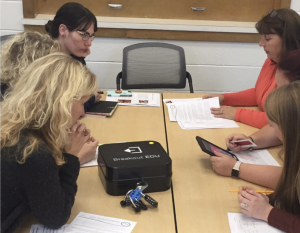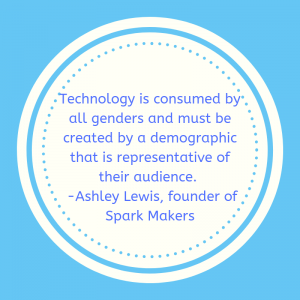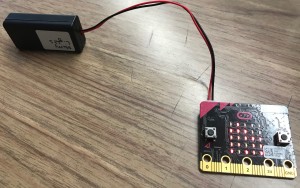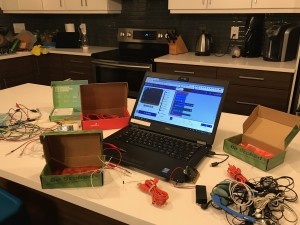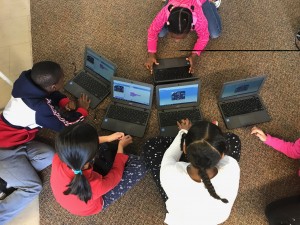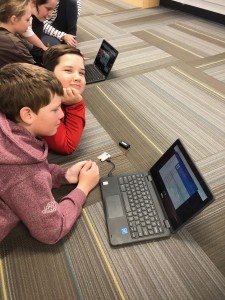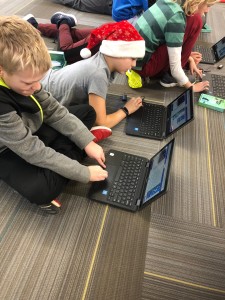Excitedly, I am back in the classroom in September! Over the past few weeks, I’ve started thinking about new ways to engage my next cohort of students. As I’ve been thinking, a friend reached out to share that her son has been enjoying podcasts and that got me thinking about how they might be useful in the classroom. I started listening to the few mentioned to me by my friend and through searching, realized just how many there are for children. For this post, I’ve included a little about the few that I’ve started listening to so far and how they might be useful in the classroom. By no means is this an exhaustive list, nor have I really had the time to dig into this idea but I’m starting here and will continue to take time over the summer listening and trying to find ways to move students from podcast consumers into perhaps podcast creators.
Six Minutes
Description from Kids Listen: Eleven-year-old Holiday is pulled from the icy waters of Alaska with no memory of who she is or where she came from. Are her mom and dad really who they say they are? And when she begins to develop incredible abilities, she’ll soon discover she’s not alone in the world. Six Minutes is a new mystery adventure for the whole family. Starting on March 1st, new six minute episodes, twice a week, all year long…and beyond.
In the first episode, the Anders family goes on a whale watching trip and finds something miraculous floating in the water. While listening to this episode, I immediately found myself using my imagination to think of what the setting and characters might look like. Because there were no visuals provided, I had to envision the space as the story started to unfold. I started to wonder about having students draw their visualizations as they listened. What would they include on a page and why? What elements might be most important for some and less for others? How might students justify their reasons for adding what they did to the page. I started to think of the creativity and critical thinking skills that could be developed through conversations about what their images may include. I like the fact that the episodes are short. Six minutes is just enough time to capture your attention while leaving you wanting more. I might also think about developing key questions to ask students for each of the episodes, getting them to piece together elements of the story as they unfold, while making predictions of what might come. I only listened to a few of the episodes and this is definitely a podcast that I would listen to myself.
Tumble Science Podcasts for Kids
Description from Kids Listen: Exploring stories of science discovery. Tumble is a science podcast created to be enjoyed by the entire family. Hosted & produced by Lindsay Patterson (science journalist) & Marshall Escamilla (teacher).
As a Science enthusiast, I was intrigued by this podcast and of course I decided to listen to one of the most gross episodes, The Tower of the Vomiting Robot with Anna Rothschild. While it took some time to get into the actual episode, the podcast told how a robot named Vomiting Larry, helped scientists discover how to stop the spread of Norovirus. I thought it was great that this episode sought to find out from grade 4 students what they thought was gross. I think this could be a great way to also include answers from your own students. This episode also got me thinking about the practical applications of technology to advance research about disease prevention and possibly a new design project for grade 5 students in relation to the human body. I also thought that it was neat that there was a blog post about the episode where students could investigate more, if they wanted to. A great way to bring in real-world science to the science we do in classrooms with students.
The Unexplainable Disappearance of Mars Patel
Description from Kids Listen: The Unexplainable Disappearance of Mars Patel is a high-quality serial mystery story for middle graders, performed by actual kids. Think Goonies, meets Spy Kids, meets Stranger Things for 8-12 year-olds. Listen along as eleven-year-old Mars Patel and his pals JP, Toothpick, and Caddie set out on an audacious adventure in search of two missing friends. The mysterious tech billionaire Oliver Pruitt might have a thing-or-two to say about their quest, because as he likes to say, To the stars! In fact, that’s just where they might be headed.
With three seasons to this podcast, I love the fact that it’s narrated by actual children. It’s in their voices and I see how it might be totally relatable and of great interest to them. A little longer in length – 30 minutes – it might be a little long for some to listen to in its entirety in the classroom but I’ve heard that it’s engaging for students and time seems to pass very quickly. I like how Oliver Pruitt in the first episode drops you into H. G. Wells Middle School. Again, I can see how students could visualize what is happening as well as make predictions on what might come in the next part.
The following is a list of sites that I will be investigating over the summer to find podcasts that might be interesting to introduce to my students. That being said, I know that choice and voice are extremely important and I also look forward to having conversations with my students around what they may already be listening to. Again, while I’m new to this idea of podcasts in the classroom, these lists are simply ones that I have found online that may or may not include podcasts that are ideal for your students. I think it’s wise to take a listen first and determine that for yourself. In these lists, you’ll see that there is some overlap and perhaps that might be a place to start as you investigate.
Kids Listen – An app that has podcasts sorted in categories based on age. I found it easy to listen to podcasts on my Chromebook which also got me thinking about the ease of use within the classroom depending on the technology available.
We Are Teachers – Curated list of the 18 best podcasts for students in elementary, middle and high school and also gives a sample activity to try along with listening to the podcast.
Cult of Pedagogy – Offers a brief reason what podcasts are and how they can be listened to, along with 8 educational podcasts with a sample episode and brief descriptions of each.
Scholastic – Gives you a list of 9 podcasts, telling you what they are best for, why it’s worth it and where to find them.
Common Sense Media – With fantastic tips for parents and children, this list of the 20 best podcasts has them organized by category based on genres or activities.
Common Sense Media – Another list specifically for little kids, truly highlighting that podcasts can be for everyone.
Finding Cleo – Definitely for older students, this link is to a teacher’s guide developed by the Dufferin Peel Catholic District School Board educators, for this podcast. Included are letters to parents, suggested assignments for the episodes and further resources.
Have you used podcasts with students? If so, how? What worked and what didn’t work? I would love to hear your experiences and get some ideas from you.
However you spend your summer break, I hope that it’s filled with time to relax and rejuvenate for the upcoming year. Have a happy and safe summer!
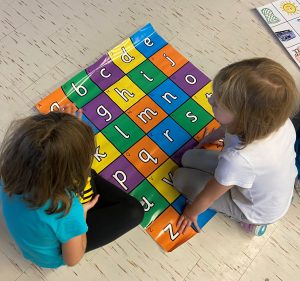 I have taught every grade from K-8 in some way, shape or form. I can say that without a doubt or apology I have more respect for Kindergarten teachers than any other grade level. Hands down. I have loved every grade I taught while I was teaching it. I was young and without children when I taught Kindergarten and can say that there is no tired like Kindergarten teacher tired. That being said, I absolutely love going into Kindergarten classes with robotics. Unabashedly Kinder friends approach you to ask your name and promptly tell you about the “owie” on the bottom of their foot as soon as they walk in the door.
I have taught every grade from K-8 in some way, shape or form. I can say that without a doubt or apology I have more respect for Kindergarten teachers than any other grade level. Hands down. I have loved every grade I taught while I was teaching it. I was young and without children when I taught Kindergarten and can say that there is no tired like Kindergarten teacher tired. That being said, I absolutely love going into Kindergarten classes with robotics. Unabashedly Kinder friends approach you to ask your name and promptly tell you about the “owie” on the bottom of their foot as soon as they walk in the door.
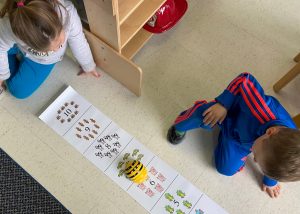
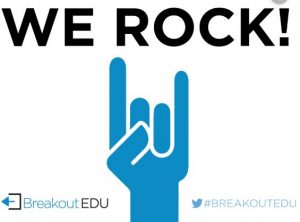
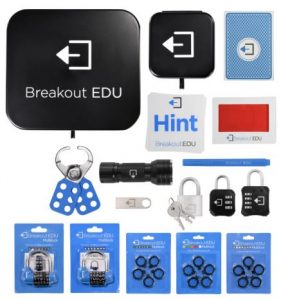 https://www.breakoutedu.com/
https://www.breakoutedu.com/